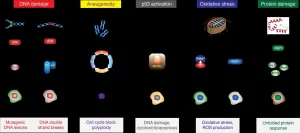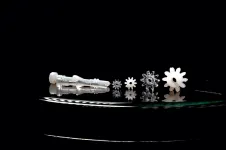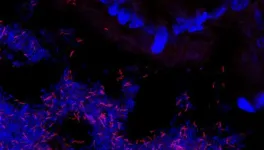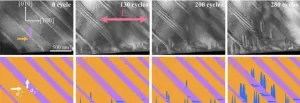Interleukin-33 involved in immunity to Sars-CoV-2
Freiburg researchers dissect Covid-19 immunity of recovered patients
2021-04-09
(Press-News.org) Since the beginning of the coronavirus pandemic, scientists and physicians worldwide undertook enormous efforts to understand the disease caused by the virus. In their latest collaborative study, researchers from the Max Planck Institute of Immunobiology and Epigenetics in Freiburg and physicians from the University of Freiburg Medical Center unveil a novel feature of COVID-19 immunity, which could have implications for future therapies. The study points to the involvement of Interleukin 33, an important danger signal, when immune cells encounter Sars-CoV-2 for a second time.
"We started the study at a very early stage of the pandemic in 2020 when not much was known about the immune response post-infection", says Erika Pearce, group leader at the Max Planck Institute of Immunobiology and Epigenetics. "Our aim was to examine the development of immunity in people recovering from Covid-19."
Antibodies stick around
An infection with Sars-CoV-2 triggers a complex immune response necessary for the development of immunity to the virus. In simple terms, two linked branches of our immune system need to remember the virus to prevent reinfection, namely antibody-producing B cells and memory T cells. Understanding how this happens in Sars-CoV-2 infection is key for controlling the Covid-19 pandemic and critical for the success of the vaccination efforts.
For the study, the team examined blood samples of 155 individuals who mostly had mild disease. They measured the amount of antibodies against the SARS-CoV-2 spike protein and found that patients maintain high levels of antibodies more than two months after infection, indicating that they will likely be protected from re-infection. "We thought this was very encouraging, but we also wanted to understand better how the immune system would react to a second encounter with the virus," says Petya Apostolova, physician and researcher in the lab of Erika Pearce.
When the virus hits the second time
Effective immunity to a virus is reached when sufficient antibodies and memory T cells are present in the blood of a person who has recovered from the disease or has been vaccinated. To test how this happens after Covid-19, the team exposed blood cells from participants who had antibodies against Sars-CoV-2 to a portion of the virus. They observed that memory T cells had developed and quickly responded to viral proteins. "We measured a broad panel of molecules that our immune cells use to communicate with each other. It was most fascinating to us that of all these measurements, the amount of Interleukin 33 was the closest match to the amount of antibodies people had, and to the activation of their memory T cells," explains Apostolova. Interleukin 33 (IL-33) is released by cells that sense danger in their environment and has been previously linked to chronic lung disease. IL-33 can have beneficial effects by activating T cells and inducing antibody production, but it can also promote inflammation of the lung. For the first time, this study has linked IL-33 production to immunity to Sars-CoV-2.
"We believe that Interleukin 33, which is normally produced as an alarm-signal, could be an important link between protection and disease severity," says Cornelius Waller from the University of Freiburg Medical Center. Indeed, by analyzing public data of lung cells taken from patients during Sars-CoV-2 infection, the researchers were able to show that Interleukin 33 was produced in their lungs. However, identifying the implications of these findings also in the context of lung tissue damage after severe Covid-19 infections will require more investigation.
The group of researchers hopes this collaboration will continue. As Waller pointed out, "we were able to discover this much so quickly through this fantastic synergy between clinicians experienced in the care for Covid-19 patients and experts in the immunology field." The researchers hope that this study might pave the way to better understanding immunity to Sars-CoV-2 and other viral infections.
INFORMATION:
ELSE PRESS RELEASES FROM THIS DATE:
2021-04-09
An international group of scientists led by the RIKEN Cluster for Pioneering Research have studied the chemical composition of 50 protoplanetary-disk forming regions in the Perseus Molecular Cloud, and found that despite being in the same cloud, the amounts of complex organic molecules they contain are quite different. Interestingly, the chemically rich young disks have similar compositions of organic molecules. These findings raise an important question: do solar-like systems share a common chemistry at birth?
It was once believed that complex organic molecules were rare in the universe, and that this rarity ...
2021-04-09
Imperial Brands scientists have utilised Toxys' ToxTracker suite of stem-cell based in-vitro assays, which provide mechanistic insight into the potential DNA damaging properties of chemicals, comparing vape e-liquid samples and their aerosols to combustible cigarette smoke.
Imperial scientists are the first to publish results using the ToxTracker system for the assessment of vape e-liquids and aerosols, and it forms part of the company's continuing research into the tobacco harm reduction potential of Next Generation Products (NGPs) such as vapes.
The assays help assess how product samples may impact cellular functioning across six reporter cell lines, picking up the tell-tale molecular signs of potential harm in the ...
2021-04-09
Glass is ubiquitous, from high-tech products in the fields of optics, telecommunications, chemistry and medicine to everyday objects such as bottles and windows. However, shaping glass is mainly based on processes such as melting, grinding or etching. These processes are decades old, technologically demanding, energy-intensive and severely limited in terms of the shapes that can be realized. For the first time, a team led by Prof. Dr. Bastian E. Rapp from the Laboratory of Process Technology at the Department of Microsystems Engineering at the University of Freiburg, in collaboration with the Freiburg-based start-up Glassomer, has developed a process that makes it possible to form glass easily, quickly and in almost any shape using injection ...
2021-04-09
The unpopular guests are already here. Hazel-, alder- and elm tree pollen sweep in over us during the early spring months, with birch pollen following in May. Then grass follows in June-July before mugwort pollen closes the season in late summer. All leading to more and more people suffering.
Over fifty years, the proportion of young Danes who sneeze, rub itchy eyes or suffer a blocked nose because of pollen has grown from 7-8 per cent in the 1970s to 24 per cent today. And for asthma, the proportion has risen from 4 to 12 per cent during the same period. ...
2021-04-09
Diet and the gut microbiome
With the consumption of a single type of vegetable such as spinach, hundreds of chemical components enter our digestive tract. There, they are further metabolized by the gut microbiome, a unique collection of hundreds of microbial species. The gut microbiome thus plays a major role in determining how nutrition affects our health. "So far, however, the metabolic capabilities of many of these microorganisms in the microbiome are still unknown. That means we don't know what substances they feed on and how they process them," explains ...
2021-04-09
Researchers at Lund University in Sweden have discovered that bird blood produces more heat in winter, when it is colder, than in autumn. The study is published in The FASEB Journal.
The secret lies in the energy factories of cells, the mitochondria. Mammals have no mitochondria in their red blood cells, but birds do, and according to the research team from Lund and Glasgow this means that the blood can function as a central heating system when it is cold.
"In winter, the mitochondria seem to prioritize producing more heat instead of more energy. The blood becomes a type of radiator that they can turn up when it gets colder", says Andreas Nord, researcher in evolutionary ecology at Lund University who led the study.
Until ...
2021-04-09
Ferroelectric materials are used in many devices, including memories, capacitors, actuators and sensors. These devices are commonly used in both consumer and industrial instruments, such as computers, medical ultrasound equipment and underwater sonars.
Over time, ferroelectric materials are subjected to repeated mechanical and electrical loading, leading to a progressive decrease in their functionality, ultimately resulting in failure. This process is referred to as 'ferroelectric fatigue'.
It is a main cause of the failure of a range of electronic devices, with discarded electronics a leading contributor to e-waste. Globally, tens of millions of tonnes of failed electronic devices go to landfill every year.
Using advanced ...
2021-04-09
During the acute phase of the COVID-19 pandemic, emergency department doctors, nurses and other frontline staff experienced unprecedented levels of stress and emotional exhaustion that included nightmares or insomnia, according to a UC San Francisco-led study of emergency departments across the country.
The study, among the first to assess mental health effects of the pandemic at a geographically diverse sample of emergency rooms, found that nearly one-fifth of the ER staff were at elevated risk for post-traumatic stress disorder (PTSD).
The study also reported that regular testing for COVID-19 helped to reduce stress among emergency personnel, particularly for those with previous positive antibody ...
2021-04-09
COLUMBUS, Ohio - In some men, having traditional masculine characteristics such as competitiveness and adventurousness was linked to being better fathers to infants, a new study found.
But the men in this study - highly educated and from dual-earner couples - combined those stereotypically masculine traits with the belief that they should be nurturing, highly involved fathers.
The researchers were surprised that traits often seen as old-fashioned male stereotypes were linked to more positive parenting behaviors, said study lead author Sarah Schoppe-Sullivan, professor of psychology at The Ohio State University.
It ...
2021-04-09
An international research team led by Monash University has uncovered a new technique that could speed up recovery from bone replacements by altering the shape and nucleus of individual stem cells.
The research collaboration involving Monash University, the Melbourne Centre for Nanofabrication, CSIRO, the Max Planck Institute for Medical Research and the Swiss Federal Institute of Technology in Lausanne, developed micropillar arrays using UV nanoimprint lithography that essentially 'trick' the cells to become bone.
Nanoimprint lithography allows for the creation of microscale patterns with low cost, high ...
LAST 30 PRESS RELEASES:
[Press-News.org] Interleukin-33 involved in immunity to Sars-CoV-2
Freiburg researchers dissect Covid-19 immunity of recovered patients



